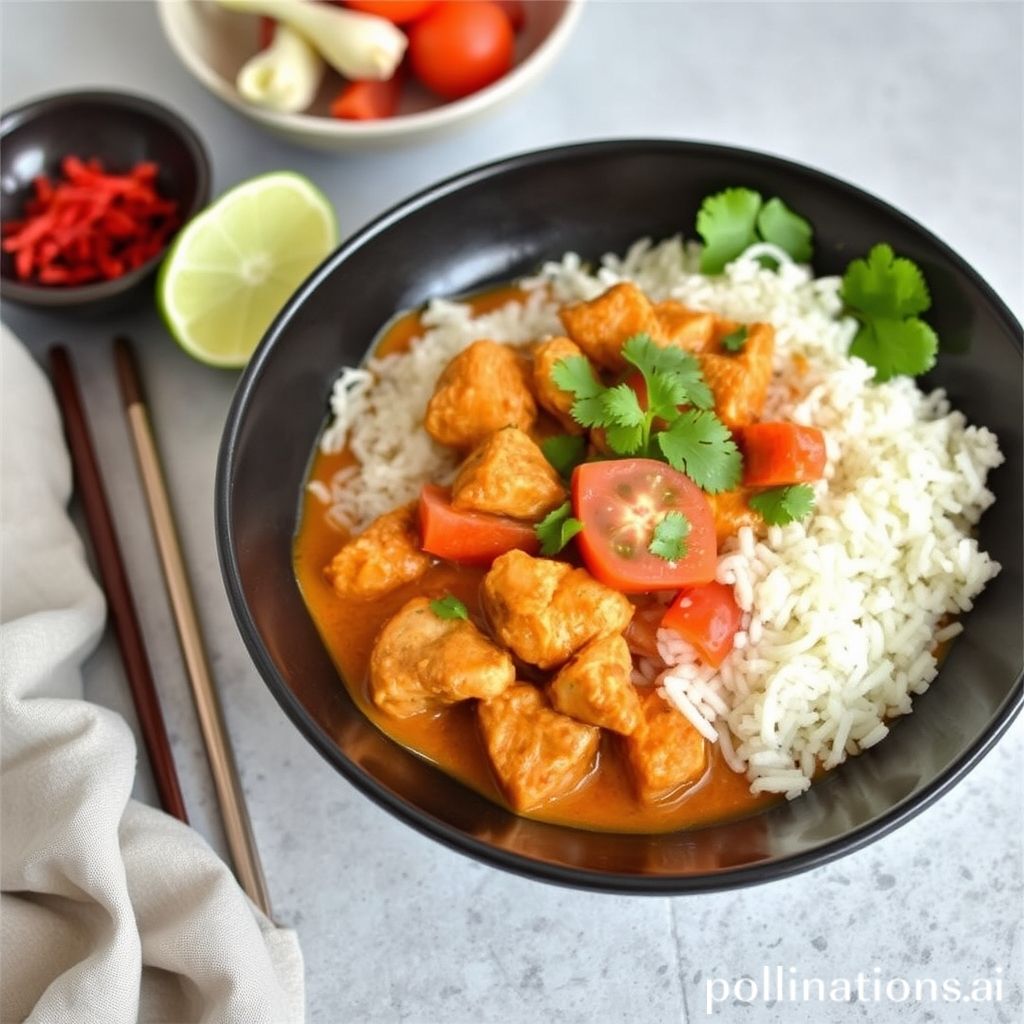Table of Contents
- Introduction
- Ingredients needed for Thai Red Curry Chicken
- Step-by-step preparation method
- Cooking tips for authentic Thai flavors
- Nutritional information and health benefits
- Pairing Thai Red Curry Chicken with side dishes
- Variations and substitutions
- Common mistakes to avoid
- Serving suggestions and presentation
- Conclusion
- Frequently Asked Questions
Introduction
Get ready to tantalize your taste buds and embark on a culinary adventure with our Thai Red Curry Chicken recipe! This beloved dish hails from the rich and diverse culinary heritage of Thailand, promising to deliver a perfect blend of spicy, sweet, and savory flavors. Whether you’re an experienced chef or a home cook looking for new inspiration, this dish is your gateway to the vibrant world of Thai cuisine.
Before we dive into the cooking process, let’s gather our ingredients:
- 1 lb chicken breast, cut into bite-sized pieces
- 2 tbsp red curry paste
- 1 can (14 oz) coconut milk
- 1 bell pepper, sliced
- 1 cup bamboo shoots, drained
- 1/2 cup green beans, trimmed
- 1 tbsp fish sauce
- 1 tbsp brown sugar
- 1 tbsp vegetable oil
- 1/4 cup Thai basil leaves
- 1 lime, cut into wedges
- Cooked jasmine rice, for serving
With these fresh and vibrant ingredients at your fingertips, you’re all set to create a dish that will transport you straight to the bustling streets of Bangkok. So, let’s delve into the art of making Thai Red Curry Chicken, and discover the secrets behind its irresistible allure!
Ingredients needed for Thai Red Curry Chicken
To make a delicious Thai Red Curry Chicken, you will need a variety of fresh ingredients that contribute to its rich, complex flavors. Here is a list of the essential ingredients:
Chicken: Boneless, skinless chicken breasts or thighs, cut into bite-sized pieces.
Red Curry Paste: This is the key flavor component made from red chilies, garlic, lemongrass, shallots, and spices.
Coconut Milk: Use full-fat coconut milk for a creamy and authentic texture.
Vegetables: Bell peppers, bamboo shoots, zucchini, and carrots are commonly used. Feel free to add or substitute with your favorite vegetables.
Fish Sauce: Adds a salty, umami depth to the curry.
Sugar: Balances the heat and saltiness. Palm sugar is traditional, but brown sugar can be used as well.
Kaffir Lime Leaves: These add a unique citrus aroma. If unavailable, lime zest can be a substitute.
Basil: Fresh Thai basil is preferred for its anise-like flavor, but regular basil can also be used.
Oil: For sautéing the curry paste and chicken, vegetable or coconut oil works well.
Rice: Typically served with jasmine rice to soak up the delicious sauce.
With these ingredients, you are well on your way to creating a flavorful and authentic Thai Red Curry Chicken.
Step-by-step preparation method
Preparing Thai Red Curry Chicken is an enjoyable and straightforward process. Begin by heating a tablespoon of oil in a large skillet or wok over medium heat. Add two to three tablespoons of red curry paste and stir-fry for about a minute to release its aromatic flavors.
Next, add diced chicken thighs or breasts, approximately 500 grams, and cook until they are no longer pink inside, usually around 5-7 minutes. Pour in one can of coconut milk, about 400ml, and bring the mixture to a simmer. At this stage, add in chopped vegetables such as bell peppers, bamboo shoots, and eggplant.
Allow the curry to cook for about 10 minutes, stirring occasionally, until the vegetables are tender. Season with a tablespoon of fish sauce and a teaspoon of sugar, adjusting to taste. If you prefer a slightly tangy flavor, squeeze in some fresh lime juice.
Finish by adding fresh Thai basil leaves and sliced red chilies for an extra kick. Serve your delicious Thai Red Curry Chicken over steamed jasmine rice, and enjoy! This dish is perfect for a quick weeknight meal or an impressive dish for guests.
Cooking tips for authentic Thai flavors
Creating an authentic Thai Red Curry Chicken dish involves more than just following a recipe; it requires understanding and utilizing key ingredients and techniques that define Thai cuisine. Fresh ingredients are essential. Always use fresh herbs like lemongrass, kaffir lime leaves, and Thai basil to achieve the vibrant flavors typical of Thai dishes. Coconut milk should be of high quality, as it forms the base of the curry’s creamy texture.
The balance of flavors is critical. Thai cuisine is known for its intricate balance of sweet, sour, salty, and spicy flavors. To achieve this, taste and adjust the seasoning with fish sauce, sugar, lime juice, and chili peppers. Don’t be afraid to taste as you cook to ensure the perfect balance.
Using a mortar and pestle to make your curry paste can greatly enhance the flavor. If time allows, pounding the ingredients by hand releases more of their natural oils and aromas. Finally, cook the curry gently. High heat can cause the coconut milk to separate; simmering allows the ingredients to meld together beautifully, creating a rich, flavorful sauce.
Follow these tips, and you’ll be well on your way to mastering the art of Thai Red Curry Chicken with authentic flavors.
Nutritional information and health benefits
Thai Red Curry Chicken is a flavorful dish that not only delights the taste buds but also offers a variety of nutritional benefits. A standard serving provides a good balance of proteins, carbohydrates, and fats, making it a wholesome meal option. Chicken is a rich source of lean protein, which is essential for muscle repair and growth. Additionally, it contains vitamins such as B6 and B12, along with minerals like phosphorus and selenium, which contribute to bone health and immune function.
The red curry paste, made from red chili peppers, garlic, and various spices, contains antioxidants that can help in reducing inflammation and boosting overall health. Coconut milk, a key ingredient, is rich in medium-chain triglycerides (MCTs), which are known to provide a quick source of energy and may aid in weight management. The dish also incorporates vegetables like bell peppers and bamboo shoots, contributing dietary fiber, vitamins, and minerals, which are essential for digestive health and overall well-being.
Overall, Thai Red Curry Chicken can be a nutritious and balanced meal when prepared with fresh, wholesome ingredients, making it a beneficial addition to a healthy diet.
Pairing Thai Red Curry Chicken with side dishes
Pairing Thai Red Curry Chicken with the right side dishes can elevate your dining experience to new heights. One of the most popular choices is jasmine rice, which not only complements the rich, spicy flavors of the curry but also helps to balance the heat. For a healthier alternative, you might consider serving the curry with brown rice or quinoa.
Steamed vegetables such as broccoli, cauliflower, and carrots make excellent accompaniments, providing a crisp texture and added nutrients. Another great option is a fresh salad, particularly one with a tangy lime vinaigrette, to offer a refreshing contrast to the bold curry flavors.
If you’re looking to add a bit more depth to your meal, try pairing the curry with Thai-style spring rolls or prawn crackers. These crunchy sides can provide a delightful contrast in texture and enhance the overall dining experience.
Finally, don’t forget about beverages. A cold Thai iced tea or a refreshing cucumber-infused water can help to cool your palate and round out the meal beautifully. Experimenting with these pairings can help you discover your perfect Thai Red Curry Chicken experience.
Variations and substitutions
Thai Red Curry Chicken is a versatile dish with numerous variations and substitutions that cater to different dietary preferences and ingredient availability. For instance, you can substitute chicken with tofu for a vegetarian version or use shrimp for a seafood twist. Vegetables like bell peppers, zucchini, and peas can be added or swapped based on seasonality and personal taste. Coconut milk is essential for its creamy texture, but you can opt for a lighter version or even coconut cream for a richer consistency.
When it comes to the curry paste, store-bought options are convenient, but homemade paste often offers a more robust flavor. If you can’t find red curry paste, yellow or green curry pastes serve as good alternatives, each imparting its own unique flavors. Fish sauce is commonly used for seasoning, but soy sauce or tamari can be a great substitute for those with dietary restrictions. Fresh herbs like basil or cilantro can also be added at the end to enhance the dish’s aroma and depth of flavor.
These variations and substitutions make Thai Red Curry Chicken a flexible and adaptable dish, allowing you to customize it to your liking while retaining its core essence.
Common mistakes to avoid
Thai Red Curry Chicken is a beloved dish, but even seasoned cooks can make common mistakes that affect its authenticity and flavor. One common mistake is using the wrong type of coconut milk. Always opt for full-fat coconut milk for a rich and creamy texture; low-fat versions can make the curry watery.
Avoid rushing the cooking process. Allow the curry paste to sauté properly to release its full range of flavors before adding other ingredients. This step is crucial for a deep, aromatic curry.
Another error to avoid is overcooking the vegetables. Thai Red Curry is known for its vibrant, crisp veggies, so add them towards the end of the cooking process to maintain their texture and color.
Lastly, balance is key in Thai cuisine. Be mindful of the balance between sweet, salty, spicy, and sour elements. Taste as you go and adjust seasonings like fish sauce, sugar, and lime juice accordingly. Overemphasizing any one component can throw off the intricate balance that makes Thai Red Curry Chicken so special.
Serving suggestions and presentation
When it comes to serving Thai Red Curry Chicken, presentation can elevate the dining experience. Consider serving this savory and aromatic dish in a traditional Thai-style bowl to enhance its authenticity. Accompany the curry with a side of steamed jasmine rice, which not only complements the rich flavors but also helps balance the spiciness of the dish. For added texture and color, garnishing with fresh Thai basil leaves, chopped cilantro, and thinly sliced red chili peppers can make the dish visually appealing. A wedge of lime on the side offers a zesty kick that diners can squeeze over their curry if they desire a citrusy contrast.
To further elevate the presentation, you might consider serving the curry with a side of rice noodles or even roti bread to soak up the delicious sauce. Using decorative serving platters and bowls can also make a significant difference. Additionally, placing the meal on a traditional Thai placemat or using Asian-inspired tableware can create an immersive dining experience. Finally, don’t forget the beverage! A chilled Thai iced tea or a light, citrusy beer pairs wonderfully with Thai Red Curry Chicken, rounding out the meal and making it a memorable experience for everyone.
Conclusion
In exploring the rich and flavorful world of Thai Red Curry Chicken, it’s evident that this beloved dish offers more than just a satisfying meal. From the tantalizing balance of spices and creamy coconut milk to the nutritional benefits and versatile pairings, Thai Red Curry Chicken is a culinary masterpiece that can be easily mastered in your own kitchen. Whether you’re a novice cook or a seasoned chef, the journey of creating this dish is both enjoyable and rewarding.
Ready to elevate your chicken dishes to new heights? Discover a plethora of mouth-watering recipes that will transform your culinary experiences. Don’t miss out on The Chicken Bible: Say Goodbye to Boring Chicken with 500 Recipes for Easy Dinners, Braises, Wings, Stir-Fries, and So Much More. Click here to purchase your copy today and unlock the secrets to making every chicken meal a delightful feast!

